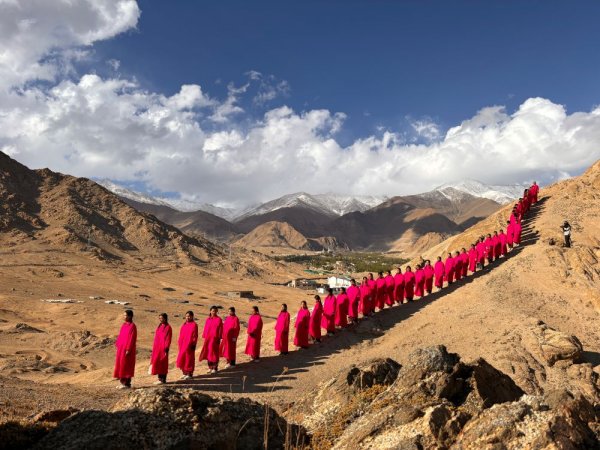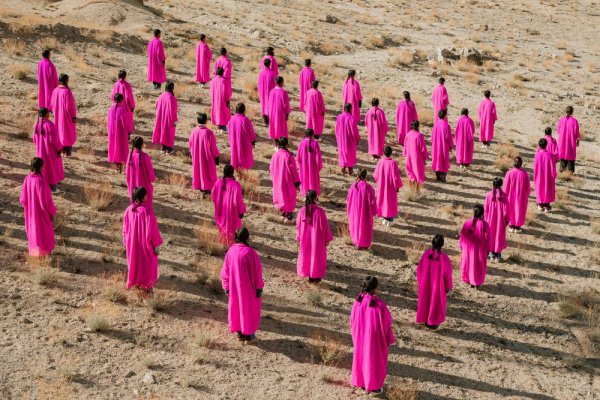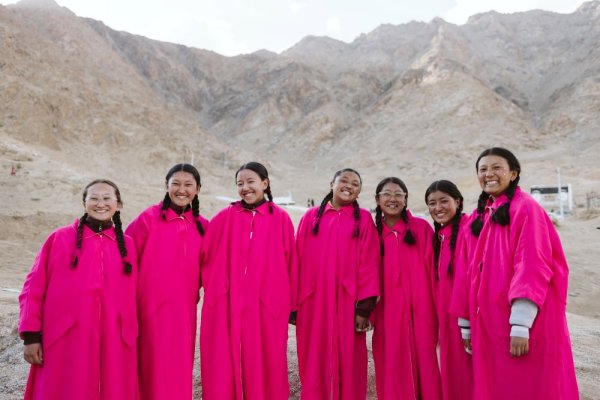
|   |

|   |
Choreography of the land at Sa Ladakh - Anurag Chauhan e-mail: anuragchauhanoffice@gmail.com Images: Black Sheep Media House June 27, 2024 Nestled in the breathtaking expanse of Leh's Disko Valley Bike Park, the Sa Ladakh Festival from June 1 to June 10, 2024, emerged as a vibrant confluence of art, culture, and nature. Conceived by Tenzing 'Jammy' Jamyang, Raki Nikahetiya, and Sagardeep Singh, this immersive event, aptly named 'sā' after the Ladakhi word for soil, breathed new life into the park with over 15 installations that seamlessly intertwined environmental stewardship with artistic expression.  Central to the festival's narrative was a captivating dance performance choreographed by Neil Ghose Balser and Doyel Joshi of 'How Are You Feeling Studio'. Working closely with 50 students aged 14 to 16 from Leh's Mahabodhi Residential School, Balser and Joshi crafted a performance that harmoniously fused Ladakhi heritage with contemporary dance forms. Inspired by the philosophical insights of James Blake, their choreography explored profound themes of liberation, expression and the intricate relationship between humanity and its natural environment. James Blake's exploration of societal constraints and personal freedom provided a compelling conceptual framework for Balser and Joshi's narrative. Themes of restriction and control, the constraints of rationality, and the oppressive influence of societal rule-makers resonated deeply. Gods and free-spirited children, depicted as stood up, jumping, or dancing, raising their arms free from the contracting forces of repression, fear, and bitterness, became a powerful metaphor. This duality of order versus oppression, set against the warmth and vitality of Mother Nature, was poignantly captured in the performance. Blake's assertion that "everything possible to be believed is an image of truth" challenged the audience to consider reality as not just what we can see, touch, hear, or feel, but also as something that we can imagine or believe. Balser and Joshi's choreographic approach was distinguished by its meticulous integration of Ladakhi cultural motifs with contemporary expression. This fusion not only honoured local heritage but also resonated deeply with global audiences, underscoring the universal language of dance in conveying authenticity and emotional depth. The performance unfolded as a visual narrative against Ladakh's awe-inspiring backdrop, evoking a spectrum of emotions from introspective contemplation to sheer wonder.  A pivotal moment in the performance came when the girls, dressed in striking pink dresses, entered the stage. The sight of these young dancers, synchronized against the rugged beauty of the Ladakhi mountains, brought goosebumps to those in the audience. The contrast of the vibrant pink against the arid landscape was a visual triumph, creating a mesmerising and unforgettable spectacle that highlighted the dancers' connection to their environment. Adding to the ambiance, a group of Ladakhi girls sang soothing local folk songs in the background, their voices harmonising with the gentle wind, creating a calming and immersive experience. The performance's conclusion, featuring a spirited rendition of Musical Chairs, exemplified the festival's ethos of community engagement and cultural celebration. As students DJed local cultural music and engaged in playful competition, the festival grounds reverberated with infectious joy. This interactive finale blurred the boundaries between performer and spectator, fostering a collective experience that bridged cultural divides and invited participants to embrace the festival's overarching themes of unity and cultural ownership.  Choreographers Neil and Doyel Balser and Joshi's choreography not only served as a medium of artistic expression but also transformed the dynamics between choreographers, performers, and the audience. It facilitated a profound exchange of emotions and perceptions, where the performers' deep connection to their land and heritage resonated with the audience. This interaction transcended the conventional rules of stage performance, inviting viewers to experience a narrative that was both deeply personal and universally resonant. As a land art festival attracting a predominantly art-savvy crowd, Sa Ladakh became symbolic of the harmonious relationship between humanity and nature. The performance pieces, including Balser and Joshi's dance, served as conduits for exploring themes of cultural identity and environmental consciousness. They inspired introspection and dialogue about the intersections of tradition and innovation within Ladakh's cultural landscape.  The exploration of the idea of perfection was integral to this performance. Perfection, in this context, was not about flawless execution but about capturing the essence of Ladakhi culture and conveying it authentically through dance. Balser and Joshi's choreography embraced imperfections as integral parts of human expression, allowing spontaneity and raw emotion to shine through. This approach invited audiences to appreciate the beauty in authenticity and to reflect on the dynamic interplay between tradition and innovation in cultural storytelling. In conclusion, the Sa Ladakh Festival transcended its role as a traditional art exhibition, becoming a dynamic platform for dialogue on environmental stewardship, cultural heritage, and community resilience. Through installations, performances, and interactive experiences, it sparked meaningful conversations about the intersections of art and nature in Ladakh's landscape. As an arts critic immersed in this transformative event, witnessing Balser and Joshi's choreography amidst Ladakh's natural splendour left an indelible impression. Their performance not only celebrated Ladakh's rich cultural heritage but also challenged perceptions of perfection in art, ultimately underscoring the festival's mission to foster a deeper connection between people and their environment. The next edition of the festival is being planned for 2026 in Ladakh.  Anurag Chauhan, an award-winning social worker and arts impresario, combines literature and philanthropy to inspire positive change. His impactful storytelling and cultural events enrich lives and communities. |